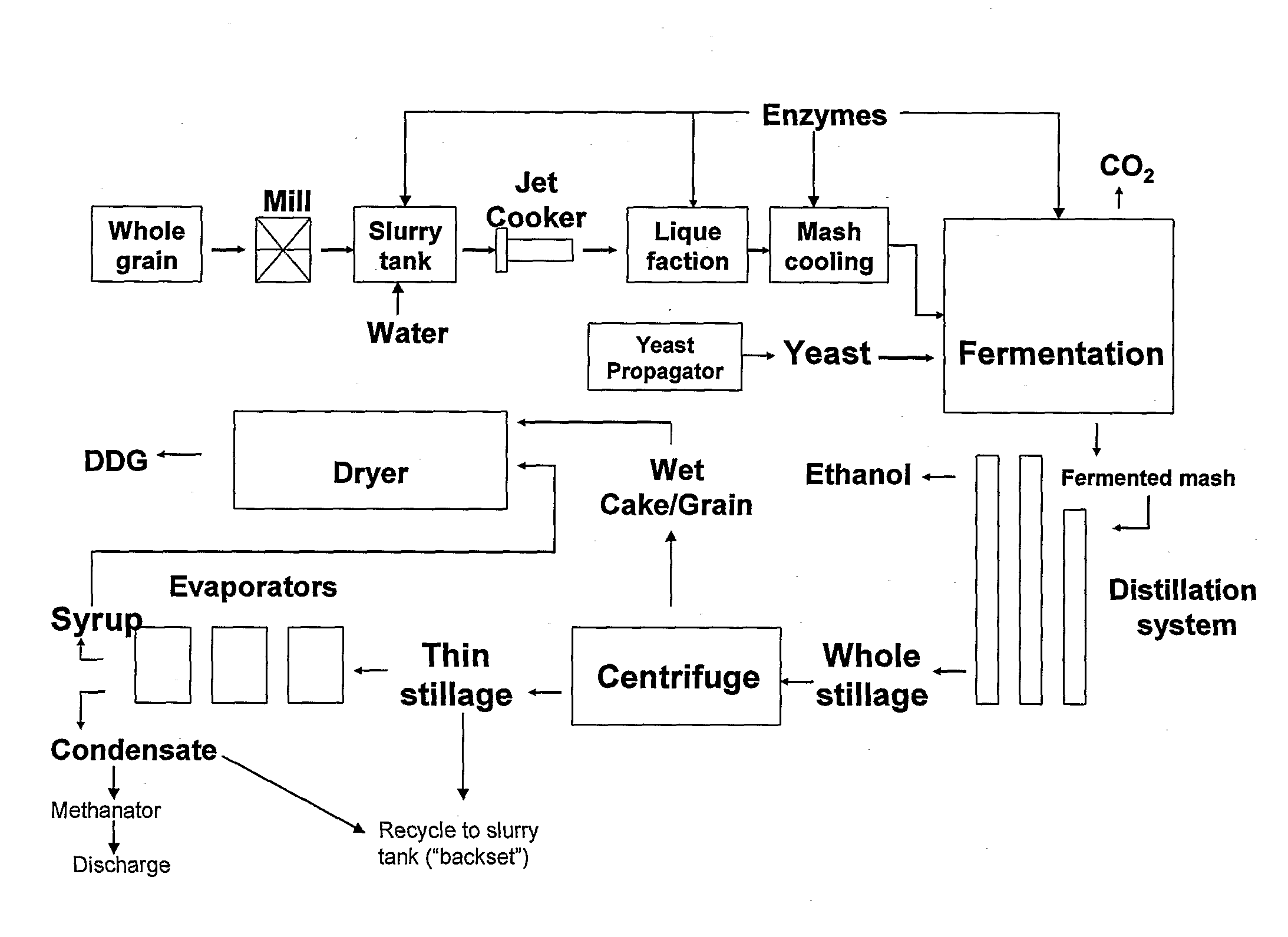Dewatering Whole Stillage
a technology of enzymatic dewatering and whole stillage, which is applied in the field of enzymatic dewatering whole stillage, can solve the problems of consuming up to one-third of the energy requirement and energy-consuming dewatering of whole stillag
- Summary
- Abstract
- Description
- Claims
- Application Information
AI Technical Summary
Benefits of technology
Problems solved by technology
Method used
Image
Examples
example 1
Dewatering Whole Stillage
[0105]Whole stillage (7.7 wt-% dry solids, pH=4.5) from conventional, dry-milled ethanol fermentation was used as substrate.
[0106]An aliquot (50 mL) of whole stillage was placed into a centrifuge tube and warmed to 40° C. Cellulase DM (1.8×106 EGU / dry ton substrate) was added and the mixture was gently agitated on a rotary shaker for 120 minutes.
[0107]The tube was centrifuged for 5 minutes at 2000 rpm.
[0108]The supernatant was decanted and the resulting wet cake was carefully transferred to a tared crucible and dried in an oven (105° C.) overnight.
[0109]The dried cake solids was weighed and compared to the control solids weight (where no enzyme was used). The results, along with several other enzymes tested, are shown in Table 1.
TABLE 1% Relative% CakeIncreasedose / DT (dry tonEnzyme1Solids1from Control2substrate)None (control)21.30——Cellulase DM22.495.591.8 × 106EGUCellulase CZ21.721.974.5 × 106ECUCellulase C21.631.555.0 × 106ECUXylanase HC21.943.000.133 × 10...
example 2
Dewatering Whole Stillage Using CST Method
[0110]For this study whole stillage from conventional ethanol fermentation of dry-milled corn was used. The dry solid content was determined to 10.58% DS using a Moisture Analyzer IR-200 (Denver Instrument). The pH of the whole stillage was measured 4.05. The pH was not adjusted during this study. A 50 mL whole stillage was pipetted into each test tube. 100 microL of the enzymes listed in the table below were added into tubes. All tubes were placed in 45° C. shaking water bath after mixing with Vortex-2 Genie (Scientific Industries). After 20 hours gentle shaking, tubes were taken out and cooled to room temperature. The dewatering effect of the enzymes was evaluated using Capillary Suction Timer (CST) (Triton Electronics, Ltd). The time of water travel on the filter paper was recorded. The shorter the time is, the better the dewatering effect is. Cellulases and / or hemicellulases including xylanase, glucanase, and mananase have dewatering eff...
example 3
Dewatering Whole Stillage Using CST Method
[0111]Whole stillage was the same as in example without modification in this study. A 50 ml whole stillage was pipetted in each test tube. A specific amount of enzyme was added into the tubes. All tubes were placed in 50° C. shaking incubator after mixing with Vortex-2 Genie (Scientific Industries). After 45 minutes shaking, tubes were taken out and cooled to room temperature. The dewatering effect of enzyme was evaluated using Capillary Suction Timer (CST) (Triton Electronics, Ltd). The results are shown in Table below.
PUM
 Login to View More
Login to View More Abstract
Description
Claims
Application Information
 Login to View More
Login to View More - R&D
- Intellectual Property
- Life Sciences
- Materials
- Tech Scout
- Unparalleled Data Quality
- Higher Quality Content
- 60% Fewer Hallucinations
Browse by: Latest US Patents, China's latest patents, Technical Efficacy Thesaurus, Application Domain, Technology Topic, Popular Technical Reports.
© 2025 PatSnap. All rights reserved.Legal|Privacy policy|Modern Slavery Act Transparency Statement|Sitemap|About US| Contact US: help@patsnap.com



